Analyzing the Doctrine of Precedent: Anachronistic Principles or Tool?
VerifiedAdded on 2023/01/11
|8
|2412
|39
Essay
AI Summary
This essay examines the doctrine of judicial precedent within the British legal system, questioning whether it clutters common law with outdated principles or serves as a valuable tool for legal facilitation. The essay discusses arguments for and against the doctrine, including its potential to create certainty and consistency versus its inflexible nature and the risk of perpetuating flawed past decisions. It analyzes the role of precedents in legal reasoning, distinguishing between precedents as laying down rules and precedents as applications of underlying principles. The essay concludes that while the doctrine can lead to anachronistic principles, it also provides sound decisions in certain cases, suggesting a need for a change in the inflexibility of lower courts being bound by precedents.
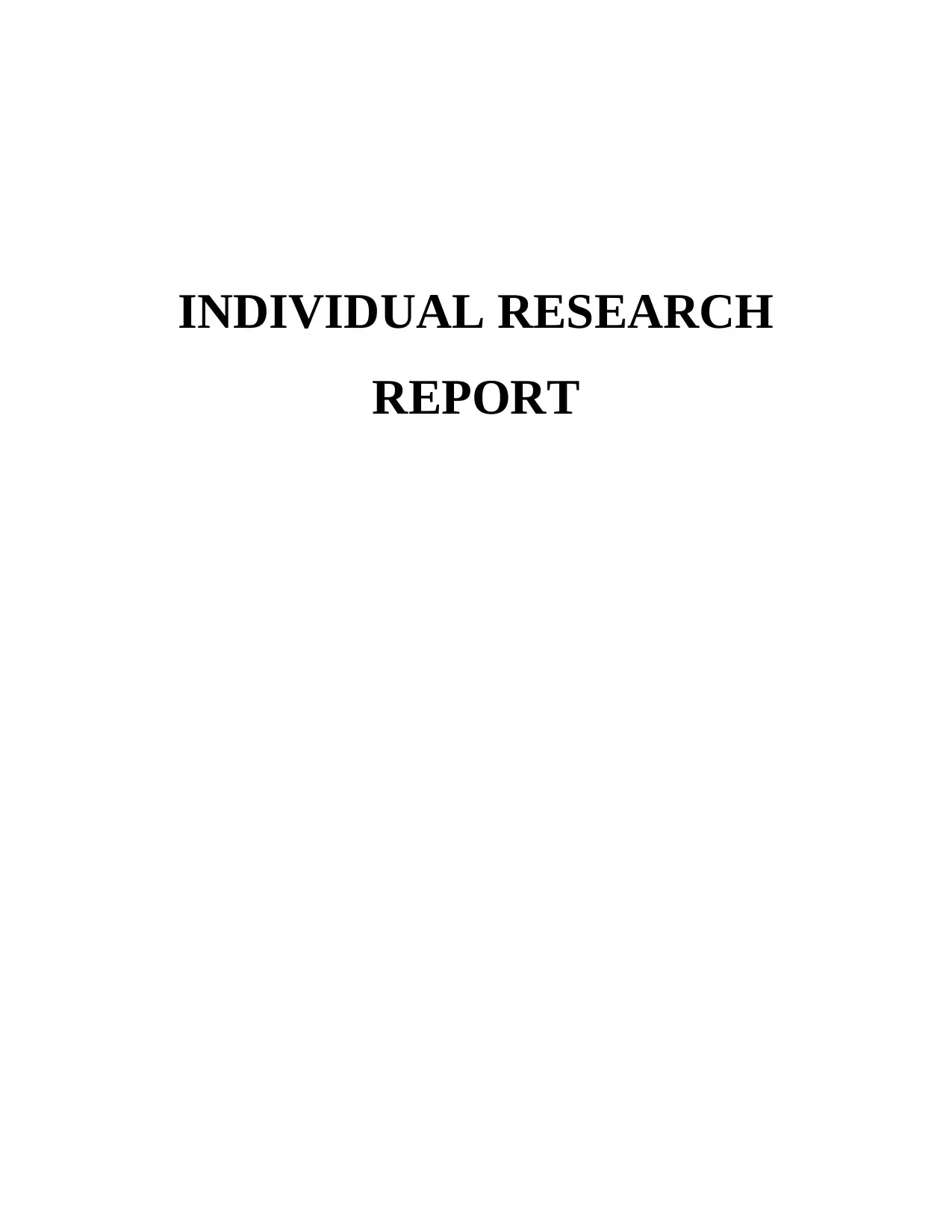
INDIVIDUAL RESEARCH
REPORT
REPORT
Paraphrase This Document
Need a fresh take? Get an instant paraphrase of this document with our AI Paraphraser
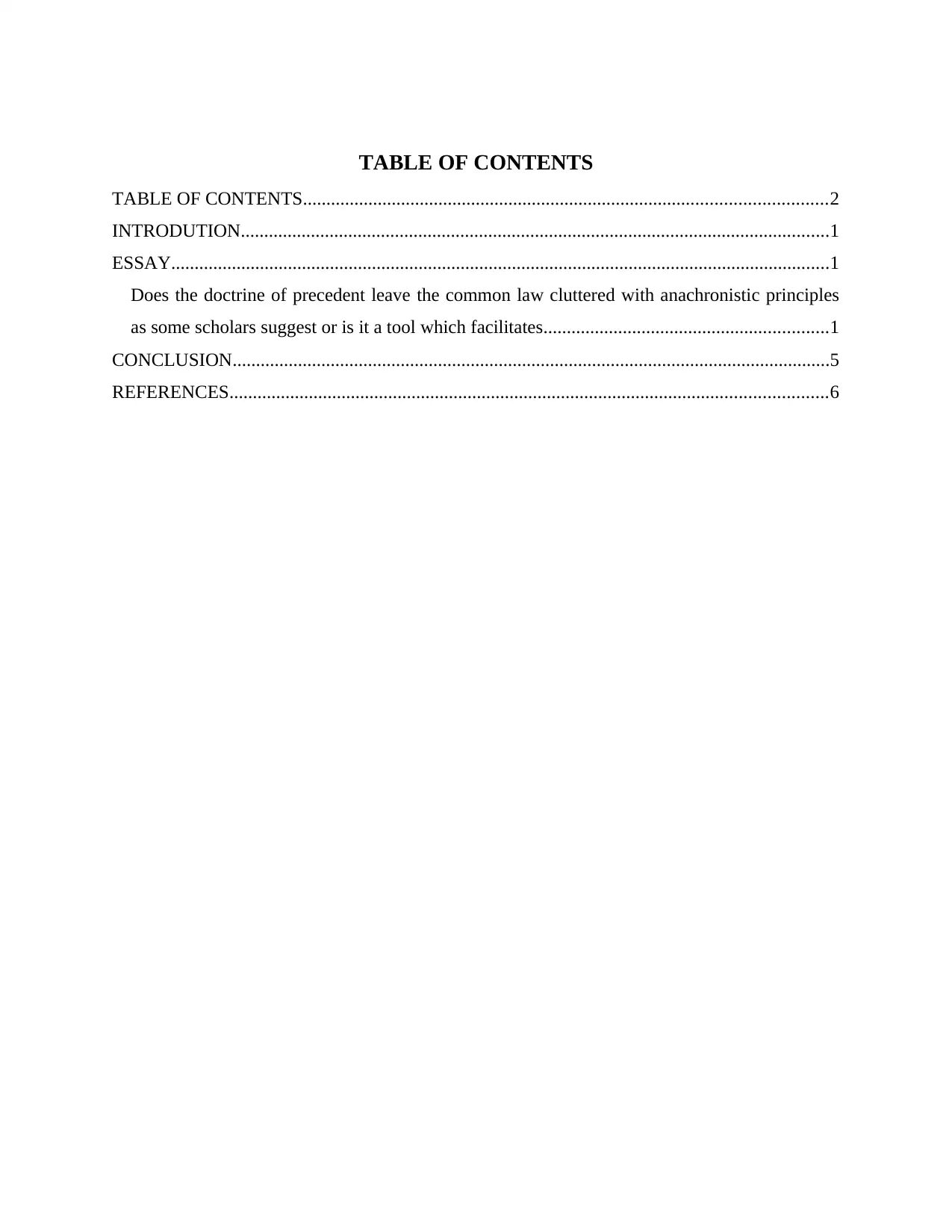
TABLE OF CONTENTS
TABLE OF CONTENTS................................................................................................................2
INTRODUTION..............................................................................................................................1
ESSAY.............................................................................................................................................1
Does the doctrine of precedent leave the common law cluttered with anachronistic principles
as some scholars suggest or is it a tool which facilitates.............................................................1
CONCLUSION................................................................................................................................5
REFERENCES................................................................................................................................6
TABLE OF CONTENTS................................................................................................................2
INTRODUTION..............................................................................................................................1
ESSAY.............................................................................................................................................1
Does the doctrine of precedent leave the common law cluttered with anachronistic principles
as some scholars suggest or is it a tool which facilitates.............................................................1
CONCLUSION................................................................................................................................5
REFERENCES................................................................................................................................6
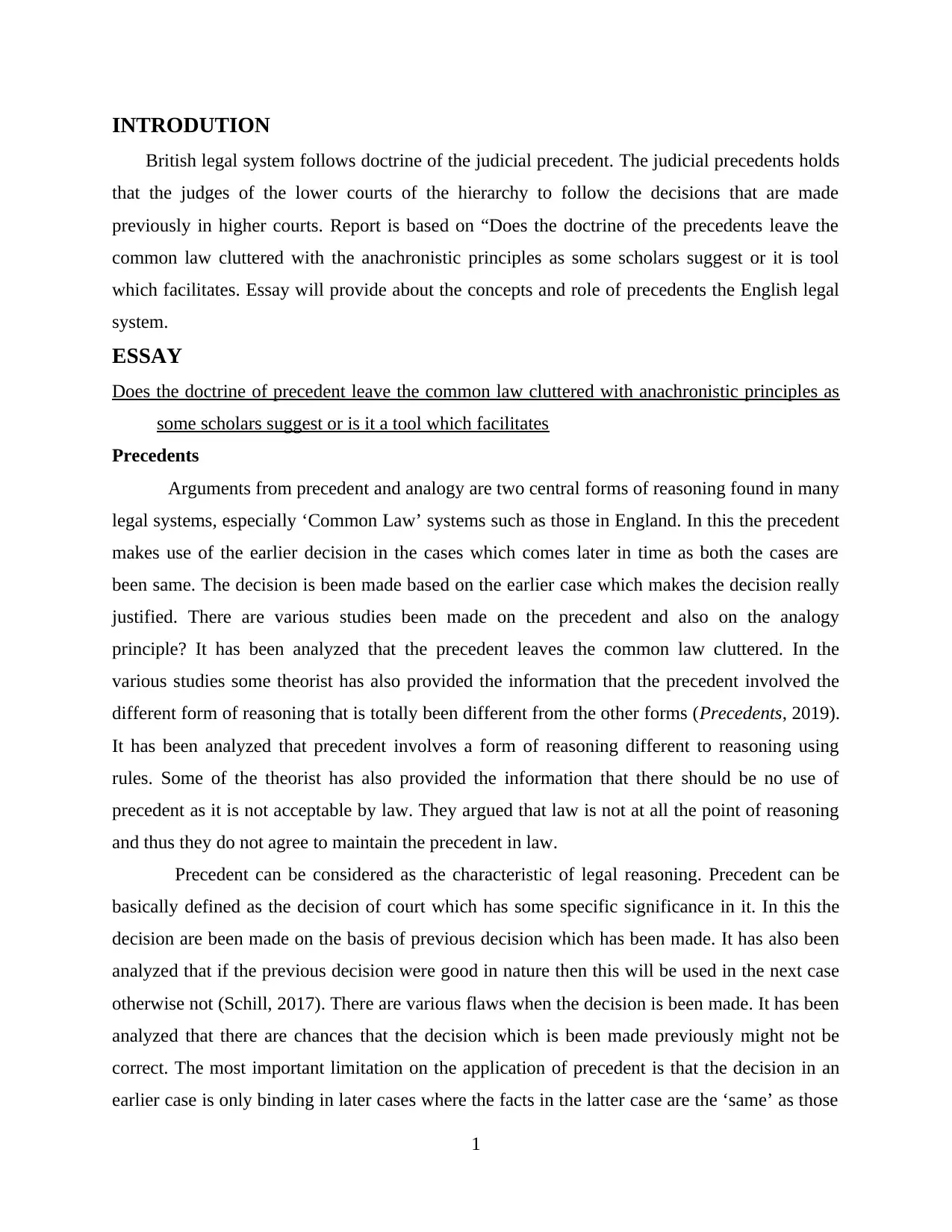
INTRODUTION
British legal system follows doctrine of the judicial precedent. The judicial precedents holds
that the judges of the lower courts of the hierarchy to follow the decisions that are made
previously in higher courts. Report is based on “Does the doctrine of the precedents leave the
common law cluttered with the anachronistic principles as some scholars suggest or it is tool
which facilitates. Essay will provide about the concepts and role of precedents the English legal
system.
ESSAY
Does the doctrine of precedent leave the common law cluttered with anachronistic principles as
some scholars suggest or is it a tool which facilitates
Precedents
Arguments from precedent and analogy are two central forms of reasoning found in many
legal systems, especially ‘Common Law’ systems such as those in England. In this the precedent
makes use of the earlier decision in the cases which comes later in time as both the cases are
been same. The decision is been made based on the earlier case which makes the decision really
justified. There are various studies been made on the precedent and also on the analogy
principle? It has been analyzed that the precedent leaves the common law cluttered. In the
various studies some theorist has also provided the information that the precedent involved the
different form of reasoning that is totally been different from the other forms (Precedents, 2019).
It has been analyzed that precedent involves a form of reasoning different to reasoning using
rules. Some of the theorist has also provided the information that there should be no use of
precedent as it is not acceptable by law. They argued that law is not at all the point of reasoning
and thus they do not agree to maintain the precedent in law.
Precedent can be considered as the characteristic of legal reasoning. Precedent can be
basically defined as the decision of court which has some specific significance in it. In this the
decision are been made on the basis of previous decision which has been made. It has also been
analyzed that if the previous decision were good in nature then this will be used in the next case
otherwise not (Schill, 2017). There are various flaws when the decision is been made. It has been
analyzed that there are chances that the decision which is been made previously might not be
correct. The most important limitation on the application of precedent is that the decision in an
earlier case is only binding in later cases where the facts in the latter case are the ‘same’ as those
1
British legal system follows doctrine of the judicial precedent. The judicial precedents holds
that the judges of the lower courts of the hierarchy to follow the decisions that are made
previously in higher courts. Report is based on “Does the doctrine of the precedents leave the
common law cluttered with the anachronistic principles as some scholars suggest or it is tool
which facilitates. Essay will provide about the concepts and role of precedents the English legal
system.
ESSAY
Does the doctrine of precedent leave the common law cluttered with anachronistic principles as
some scholars suggest or is it a tool which facilitates
Precedents
Arguments from precedent and analogy are two central forms of reasoning found in many
legal systems, especially ‘Common Law’ systems such as those in England. In this the precedent
makes use of the earlier decision in the cases which comes later in time as both the cases are
been same. The decision is been made based on the earlier case which makes the decision really
justified. There are various studies been made on the precedent and also on the analogy
principle? It has been analyzed that the precedent leaves the common law cluttered. In the
various studies some theorist has also provided the information that the precedent involved the
different form of reasoning that is totally been different from the other forms (Precedents, 2019).
It has been analyzed that precedent involves a form of reasoning different to reasoning using
rules. Some of the theorist has also provided the information that there should be no use of
precedent as it is not acceptable by law. They argued that law is not at all the point of reasoning
and thus they do not agree to maintain the precedent in law.
Precedent can be considered as the characteristic of legal reasoning. Precedent can be
basically defined as the decision of court which has some specific significance in it. In this the
decision are been made on the basis of previous decision which has been made. It has also been
analyzed that if the previous decision were good in nature then this will be used in the next case
otherwise not (Schill, 2017). There are various flaws when the decision is been made. It has been
analyzed that there are chances that the decision which is been made previously might not be
correct. The most important limitation on the application of precedent is that the decision in an
earlier case is only binding in later cases where the facts in the latter case are the ‘same’ as those
1
You're viewing a preview
Unlock full access by subscribing today!
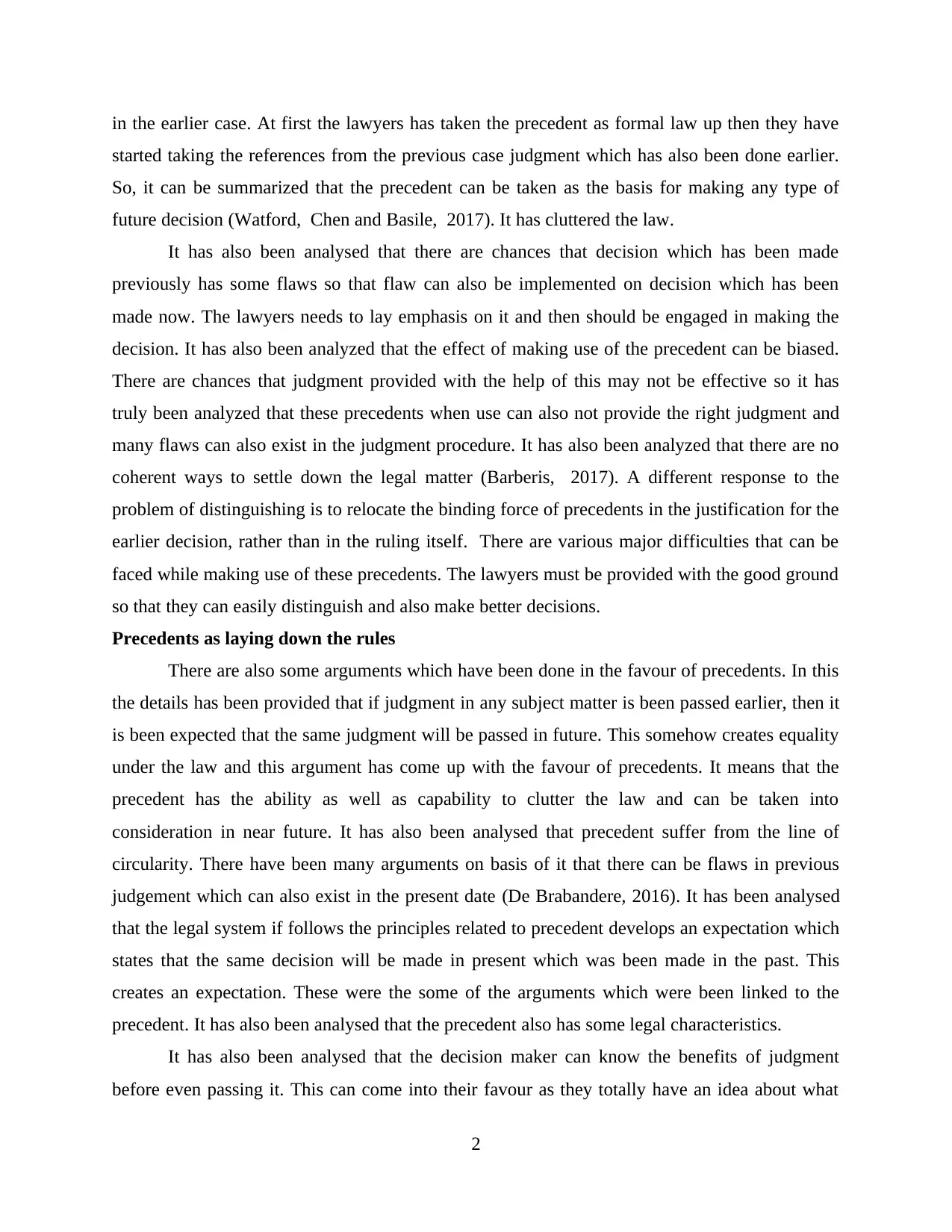
in the earlier case. At first the lawyers has taken the precedent as formal law up then they have
started taking the references from the previous case judgment which has also been done earlier.
So, it can be summarized that the precedent can be taken as the basis for making any type of
future decision (Watford, Chen and Basile, 2017). It has cluttered the law.
It has also been analysed that there are chances that decision which has been made
previously has some flaws so that flaw can also be implemented on decision which has been
made now. The lawyers needs to lay emphasis on it and then should be engaged in making the
decision. It has also been analyzed that the effect of making use of the precedent can be biased.
There are chances that judgment provided with the help of this may not be effective so it has
truly been analyzed that these precedents when use can also not provide the right judgment and
many flaws can also exist in the judgment procedure. It has also been analyzed that there are no
coherent ways to settle down the legal matter (Barberis, 2017). A different response to the
problem of distinguishing is to relocate the binding force of precedents in the justification for the
earlier decision, rather than in the ruling itself. There are various major difficulties that can be
faced while making use of these precedents. The lawyers must be provided with the good ground
so that they can easily distinguish and also make better decisions.
Precedents as laying down the rules
There are also some arguments which have been done in the favour of precedents. In this
the details has been provided that if judgment in any subject matter is been passed earlier, then it
is been expected that the same judgment will be passed in future. This somehow creates equality
under the law and this argument has come up with the favour of precedents. It means that the
precedent has the ability as well as capability to clutter the law and can be taken into
consideration in near future. It has also been analysed that precedent suffer from the line of
circularity. There have been many arguments on basis of it that there can be flaws in previous
judgement which can also exist in the present date (De Brabandere, 2016). It has been analysed
that the legal system if follows the principles related to precedent develops an expectation which
states that the same decision will be made in present which was been made in the past. This
creates an expectation. These were the some of the arguments which were been linked to the
precedent. It has also been analysed that the precedent also has some legal characteristics.
It has also been analysed that the decision maker can know the benefits of judgment
before even passing it. This can come into their favour as they totally have an idea about what
2
started taking the references from the previous case judgment which has also been done earlier.
So, it can be summarized that the precedent can be taken as the basis for making any type of
future decision (Watford, Chen and Basile, 2017). It has cluttered the law.
It has also been analysed that there are chances that decision which has been made
previously has some flaws so that flaw can also be implemented on decision which has been
made now. The lawyers needs to lay emphasis on it and then should be engaged in making the
decision. It has also been analyzed that the effect of making use of the precedent can be biased.
There are chances that judgment provided with the help of this may not be effective so it has
truly been analyzed that these precedents when use can also not provide the right judgment and
many flaws can also exist in the judgment procedure. It has also been analyzed that there are no
coherent ways to settle down the legal matter (Barberis, 2017). A different response to the
problem of distinguishing is to relocate the binding force of precedents in the justification for the
earlier decision, rather than in the ruling itself. There are various major difficulties that can be
faced while making use of these precedents. The lawyers must be provided with the good ground
so that they can easily distinguish and also make better decisions.
Precedents as laying down the rules
There are also some arguments which have been done in the favour of precedents. In this
the details has been provided that if judgment in any subject matter is been passed earlier, then it
is been expected that the same judgment will be passed in future. This somehow creates equality
under the law and this argument has come up with the favour of precedents. It means that the
precedent has the ability as well as capability to clutter the law and can be taken into
consideration in near future. It has also been analysed that precedent suffer from the line of
circularity. There have been many arguments on basis of it that there can be flaws in previous
judgement which can also exist in the present date (De Brabandere, 2016). It has been analysed
that the legal system if follows the principles related to precedent develops an expectation which
states that the same decision will be made in present which was been made in the past. This
creates an expectation. These were the some of the arguments which were been linked to the
precedent. It has also been analysed that the precedent also has some legal characteristics.
It has also been analysed that the decision maker can know the benefits of judgment
before even passing it. This can come into their favour as they totally have an idea about what
2
Paraphrase This Document
Need a fresh take? Get an instant paraphrase of this document with our AI Paraphraser
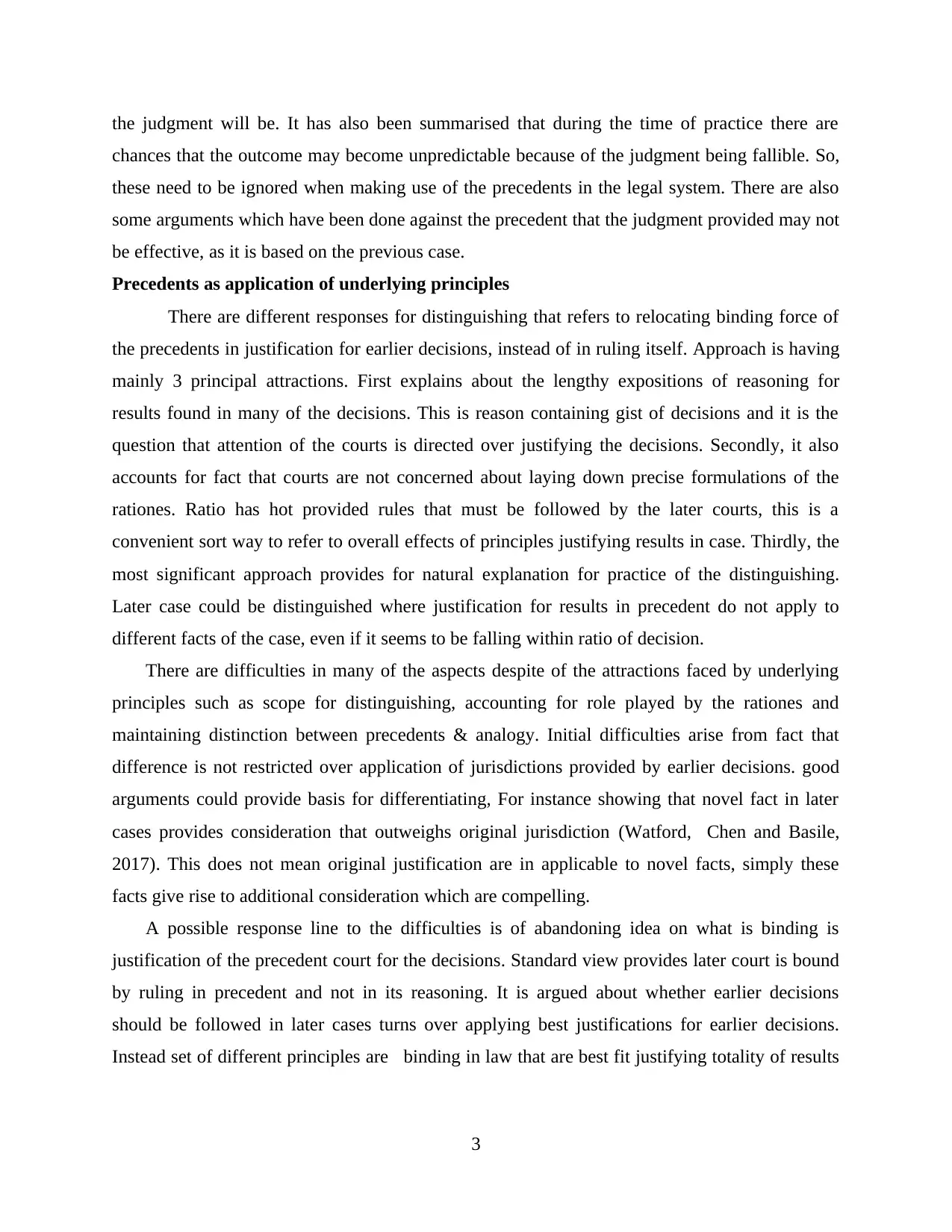
the judgment will be. It has also been summarised that during the time of practice there are
chances that the outcome may become unpredictable because of the judgment being fallible. So,
these need to be ignored when making use of the precedents in the legal system. There are also
some arguments which have been done against the precedent that the judgment provided may not
be effective, as it is based on the previous case.
Precedents as application of underlying principles
There are different responses for distinguishing that refers to relocating binding force of
the precedents in justification for earlier decisions, instead of in ruling itself. Approach is having
mainly 3 principal attractions. First explains about the lengthy expositions of reasoning for
results found in many of the decisions. This is reason containing gist of decisions and it is the
question that attention of the courts is directed over justifying the decisions. Secondly, it also
accounts for fact that courts are not concerned about laying down precise formulations of the
rationes. Ratio has hot provided rules that must be followed by the later courts, this is a
convenient sort way to refer to overall effects of principles justifying results in case. Thirdly, the
most significant approach provides for natural explanation for practice of the distinguishing.
Later case could be distinguished where justification for results in precedent do not apply to
different facts of the case, even if it seems to be falling within ratio of decision.
There are difficulties in many of the aspects despite of the attractions faced by underlying
principles such as scope for distinguishing, accounting for role played by the rationes and
maintaining distinction between precedents & analogy. Initial difficulties arise from fact that
difference is not restricted over application of jurisdictions provided by earlier decisions. good
arguments could provide basis for differentiating, For instance showing that novel fact in later
cases provides consideration that outweighs original jurisdiction (Watford, Chen and Basile,
2017). This does not mean original justification are in applicable to novel facts, simply these
facts give rise to additional consideration which are compelling.
A possible response line to the difficulties is of abandoning idea on what is binding is
justification of the precedent court for the decisions. Standard view provides later court is bound
by ruling in precedent and not in its reasoning. It is argued about whether earlier decisions
should be followed in later cases turns over applying best justifications for earlier decisions.
Instead set of different principles are binding in law that are best fit justifying totality of results
3
chances that the outcome may become unpredictable because of the judgment being fallible. So,
these need to be ignored when making use of the precedents in the legal system. There are also
some arguments which have been done against the precedent that the judgment provided may not
be effective, as it is based on the previous case.
Precedents as application of underlying principles
There are different responses for distinguishing that refers to relocating binding force of
the precedents in justification for earlier decisions, instead of in ruling itself. Approach is having
mainly 3 principal attractions. First explains about the lengthy expositions of reasoning for
results found in many of the decisions. This is reason containing gist of decisions and it is the
question that attention of the courts is directed over justifying the decisions. Secondly, it also
accounts for fact that courts are not concerned about laying down precise formulations of the
rationes. Ratio has hot provided rules that must be followed by the later courts, this is a
convenient sort way to refer to overall effects of principles justifying results in case. Thirdly, the
most significant approach provides for natural explanation for practice of the distinguishing.
Later case could be distinguished where justification for results in precedent do not apply to
different facts of the case, even if it seems to be falling within ratio of decision.
There are difficulties in many of the aspects despite of the attractions faced by underlying
principles such as scope for distinguishing, accounting for role played by the rationes and
maintaining distinction between precedents & analogy. Initial difficulties arise from fact that
difference is not restricted over application of jurisdictions provided by earlier decisions. good
arguments could provide basis for differentiating, For instance showing that novel fact in later
cases provides consideration that outweighs original jurisdiction (Watford, Chen and Basile,
2017). This does not mean original justification are in applicable to novel facts, simply these
facts give rise to additional consideration which are compelling.
A possible response line to the difficulties is of abandoning idea on what is binding is
justification of the precedent court for the decisions. Standard view provides later court is bound
by ruling in precedent and not in its reasoning. It is argued about whether earlier decisions
should be followed in later cases turns over applying best justifications for earlier decisions.
Instead set of different principles are binding in law that are best fit justifying totality of results
3
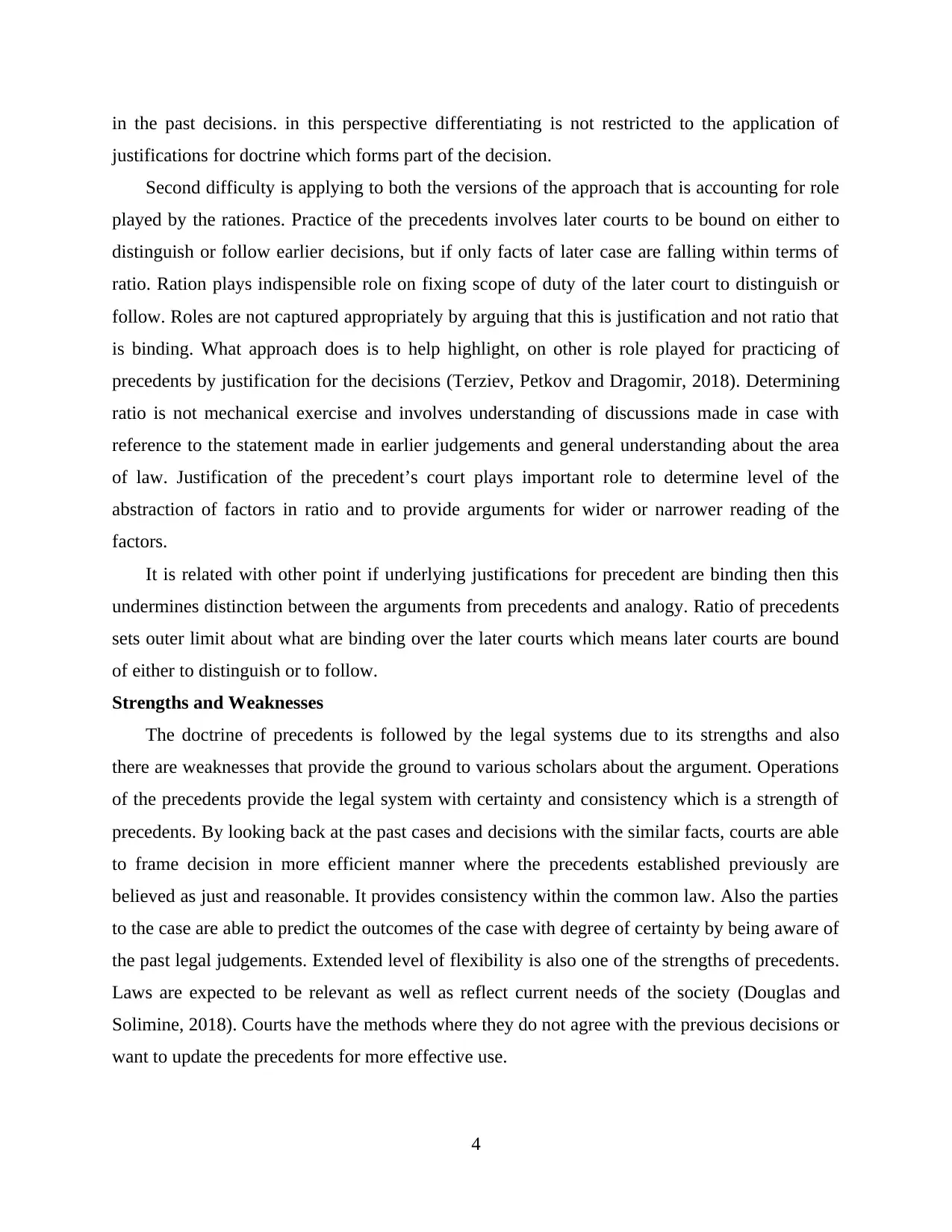
in the past decisions. in this perspective differentiating is not restricted to the application of
justifications for doctrine which forms part of the decision.
Second difficulty is applying to both the versions of the approach that is accounting for role
played by the rationes. Practice of the precedents involves later courts to be bound on either to
distinguish or follow earlier decisions, but if only facts of later case are falling within terms of
ratio. Ration plays indispensible role on fixing scope of duty of the later court to distinguish or
follow. Roles are not captured appropriately by arguing that this is justification and not ratio that
is binding. What approach does is to help highlight, on other is role played for practicing of
precedents by justification for the decisions (Terziev, Petkov and Dragomir, 2018). Determining
ratio is not mechanical exercise and involves understanding of discussions made in case with
reference to the statement made in earlier judgements and general understanding about the area
of law. Justification of the precedent’s court plays important role to determine level of the
abstraction of factors in ratio and to provide arguments for wider or narrower reading of the
factors.
It is related with other point if underlying justifications for precedent are binding then this
undermines distinction between the arguments from precedents and analogy. Ratio of precedents
sets outer limit about what are binding over the later courts which means later courts are bound
of either to distinguish or to follow.
Strengths and Weaknesses
The doctrine of precedents is followed by the legal systems due to its strengths and also
there are weaknesses that provide the ground to various scholars about the argument. Operations
of the precedents provide the legal system with certainty and consistency which is a strength of
precedents. By looking back at the past cases and decisions with the similar facts, courts are able
to frame decision in more efficient manner where the precedents established previously are
believed as just and reasonable. It provides consistency within the common law. Also the parties
to the case are able to predict the outcomes of the case with degree of certainty by being aware of
the past legal judgements. Extended level of flexibility is also one of the strengths of precedents.
Laws are expected to be relevant as well as reflect current needs of the society (Douglas and
Solimine, 2018). Courts have the methods where they do not agree with the previous decisions or
want to update the precedents for more effective use.
4
justifications for doctrine which forms part of the decision.
Second difficulty is applying to both the versions of the approach that is accounting for role
played by the rationes. Practice of the precedents involves later courts to be bound on either to
distinguish or follow earlier decisions, but if only facts of later case are falling within terms of
ratio. Ration plays indispensible role on fixing scope of duty of the later court to distinguish or
follow. Roles are not captured appropriately by arguing that this is justification and not ratio that
is binding. What approach does is to help highlight, on other is role played for practicing of
precedents by justification for the decisions (Terziev, Petkov and Dragomir, 2018). Determining
ratio is not mechanical exercise and involves understanding of discussions made in case with
reference to the statement made in earlier judgements and general understanding about the area
of law. Justification of the precedent’s court plays important role to determine level of the
abstraction of factors in ratio and to provide arguments for wider or narrower reading of the
factors.
It is related with other point if underlying justifications for precedent are binding then this
undermines distinction between the arguments from precedents and analogy. Ratio of precedents
sets outer limit about what are binding over the later courts which means later courts are bound
of either to distinguish or to follow.
Strengths and Weaknesses
The doctrine of precedents is followed by the legal systems due to its strengths and also
there are weaknesses that provide the ground to various scholars about the argument. Operations
of the precedents provide the legal system with certainty and consistency which is a strength of
precedents. By looking back at the past cases and decisions with the similar facts, courts are able
to frame decision in more efficient manner where the precedents established previously are
believed as just and reasonable. It provides consistency within the common law. Also the parties
to the case are able to predict the outcomes of the case with degree of certainty by being aware of
the past legal judgements. Extended level of flexibility is also one of the strengths of precedents.
Laws are expected to be relevant as well as reflect current needs of the society (Douglas and
Solimine, 2018). Courts have the methods where they do not agree with the previous decisions or
want to update the precedents for more effective use.
4
You're viewing a preview
Unlock full access by subscribing today!
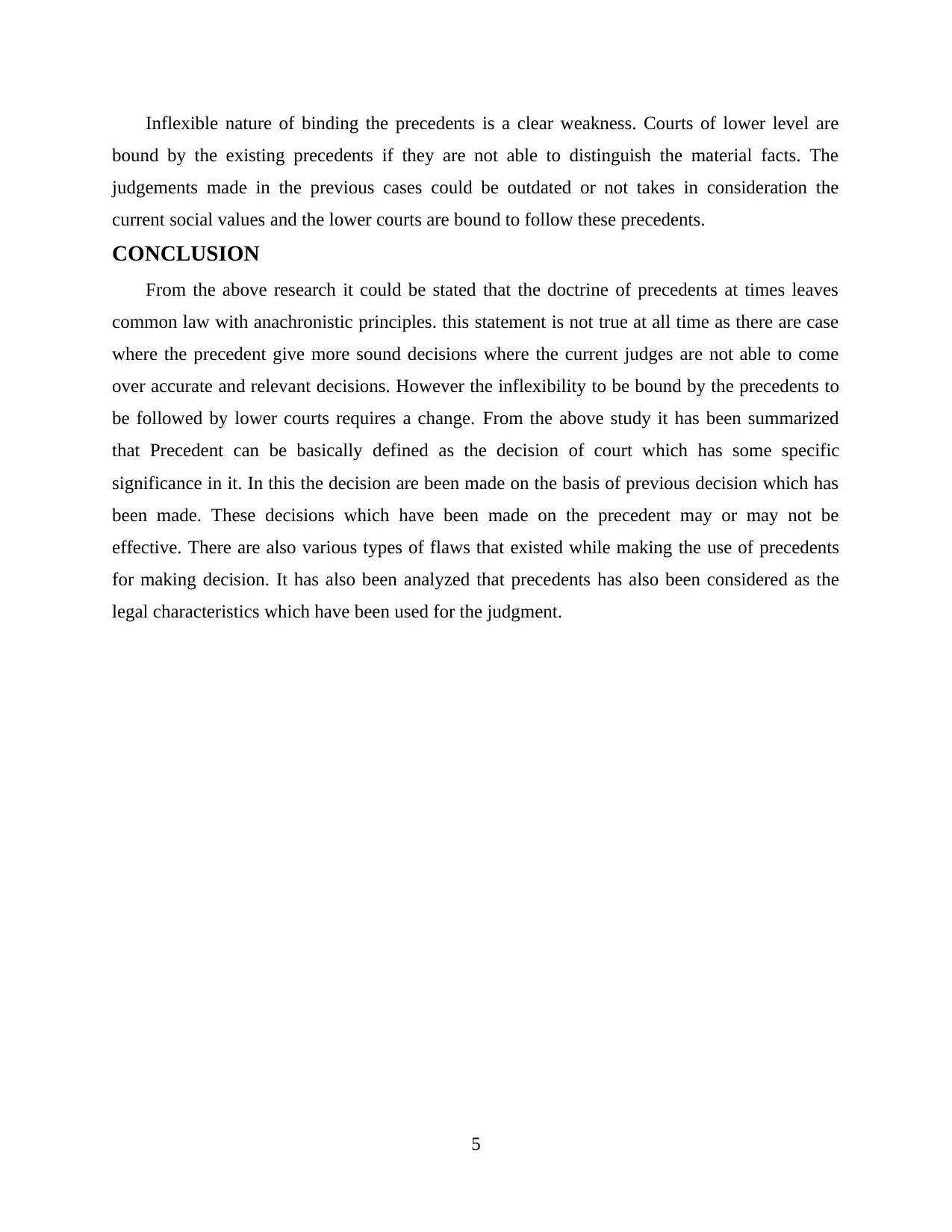
Inflexible nature of binding the precedents is a clear weakness. Courts of lower level are
bound by the existing precedents if they are not able to distinguish the material facts. The
judgements made in the previous cases could be outdated or not takes in consideration the
current social values and the lower courts are bound to follow these precedents.
CONCLUSION
From the above research it could be stated that the doctrine of precedents at times leaves
common law with anachronistic principles. this statement is not true at all time as there are case
where the precedent give more sound decisions where the current judges are not able to come
over accurate and relevant decisions. However the inflexibility to be bound by the precedents to
be followed by lower courts requires a change. From the above study it has been summarized
that Precedent can be basically defined as the decision of court which has some specific
significance in it. In this the decision are been made on the basis of previous decision which has
been made. These decisions which have been made on the precedent may or may not be
effective. There are also various types of flaws that existed while making the use of precedents
for making decision. It has also been analyzed that precedents has also been considered as the
legal characteristics which have been used for the judgment.
5
bound by the existing precedents if they are not able to distinguish the material facts. The
judgements made in the previous cases could be outdated or not takes in consideration the
current social values and the lower courts are bound to follow these precedents.
CONCLUSION
From the above research it could be stated that the doctrine of precedents at times leaves
common law with anachronistic principles. this statement is not true at all time as there are case
where the precedent give more sound decisions where the current judges are not able to come
over accurate and relevant decisions. However the inflexibility to be bound by the precedents to
be followed by lower courts requires a change. From the above study it has been summarized
that Precedent can be basically defined as the decision of court which has some specific
significance in it. In this the decision are been made on the basis of previous decision which has
been made. These decisions which have been made on the precedent may or may not be
effective. There are also various types of flaws that existed while making the use of precedents
for making decision. It has also been analyzed that precedents has also been considered as the
legal characteristics which have been used for the judgment.
5
Paraphrase This Document
Need a fresh take? Get an instant paraphrase of this document with our AI Paraphraser
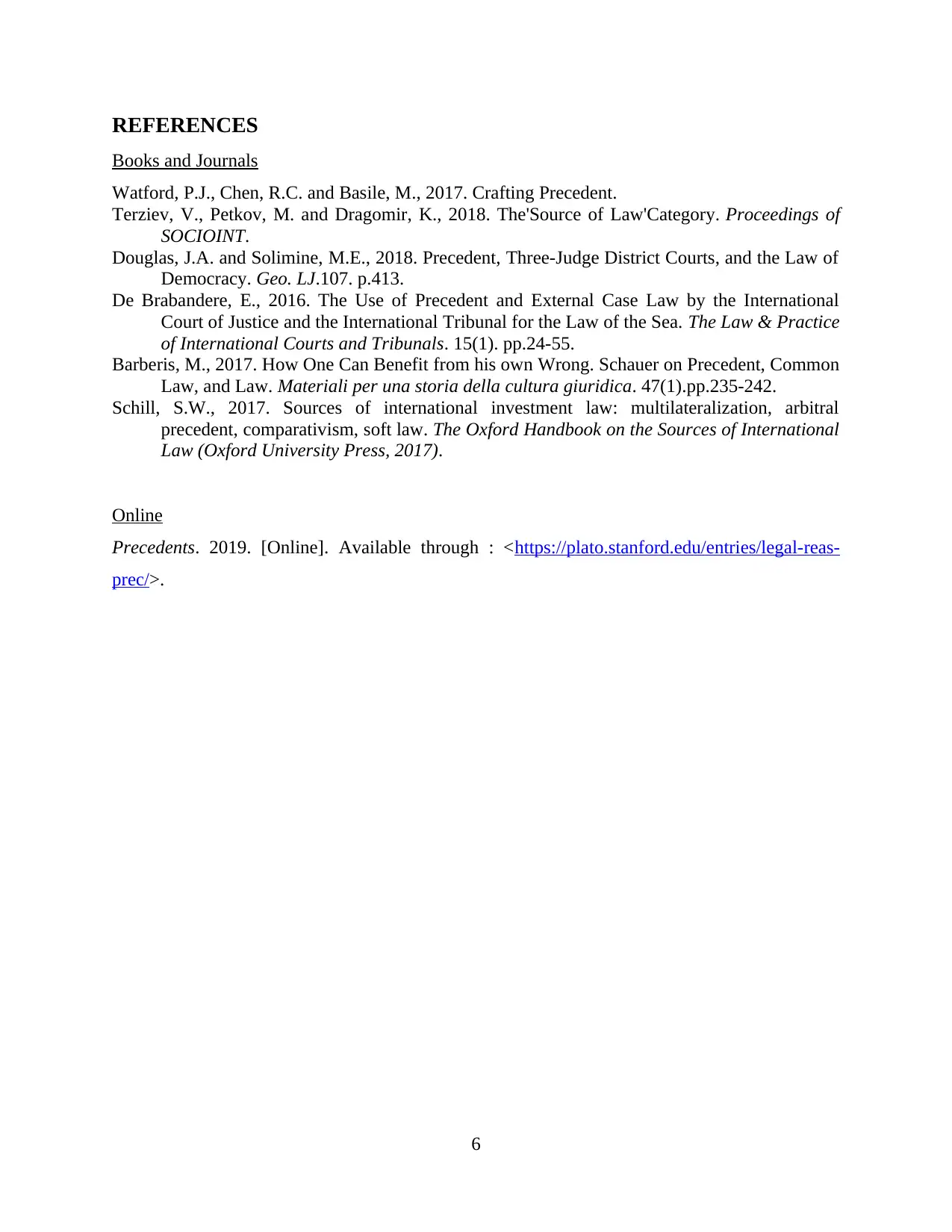
REFERENCES
Books and Journals
Watford, P.J., Chen, R.C. and Basile, M., 2017. Crafting Precedent.
Terziev, V., Petkov, M. and Dragomir, K., 2018. The'Source of Law'Category. Proceedings of
SOCIOINT.
Douglas, J.A. and Solimine, M.E., 2018. Precedent, Three-Judge District Courts, and the Law of
Democracy. Geo. LJ.107. p.413.
De Brabandere, E., 2016. The Use of Precedent and External Case Law by the International
Court of Justice and the International Tribunal for the Law of the Sea. The Law & Practice
of International Courts and Tribunals. 15(1). pp.24-55.
Barberis, M., 2017. How One Can Benefit from his own Wrong. Schauer on Precedent, Common
Law, and Law. Materiali per una storia della cultura giuridica. 47(1).pp.235-242.
Schill, S.W., 2017. Sources of international investment law: multilateralization, arbitral
precedent, comparativism, soft law. The Oxford Handbook on the Sources of International
Law (Oxford University Press, 2017).
Online
Precedents. 2019. [Online]. Available through : <https://plato.stanford.edu/entries/legal-reas-
prec/>.
6
Books and Journals
Watford, P.J., Chen, R.C. and Basile, M., 2017. Crafting Precedent.
Terziev, V., Petkov, M. and Dragomir, K., 2018. The'Source of Law'Category. Proceedings of
SOCIOINT.
Douglas, J.A. and Solimine, M.E., 2018. Precedent, Three-Judge District Courts, and the Law of
Democracy. Geo. LJ.107. p.413.
De Brabandere, E., 2016. The Use of Precedent and External Case Law by the International
Court of Justice and the International Tribunal for the Law of the Sea. The Law & Practice
of International Courts and Tribunals. 15(1). pp.24-55.
Barberis, M., 2017. How One Can Benefit from his own Wrong. Schauer on Precedent, Common
Law, and Law. Materiali per una storia della cultura giuridica. 47(1).pp.235-242.
Schill, S.W., 2017. Sources of international investment law: multilateralization, arbitral
precedent, comparativism, soft law. The Oxford Handbook on the Sources of International
Law (Oxford University Press, 2017).
Online
Precedents. 2019. [Online]. Available through : <https://plato.stanford.edu/entries/legal-reas-
prec/>.
6
1 out of 8
Related Documents
Your All-in-One AI-Powered Toolkit for Academic Success.
+13062052269
info@desklib.com
Available 24*7 on WhatsApp / Email
![[object Object]](/_next/static/media/star-bottom.7253800d.svg)
Unlock your academic potential
© 2024 | Zucol Services PVT LTD | All rights reserved.





